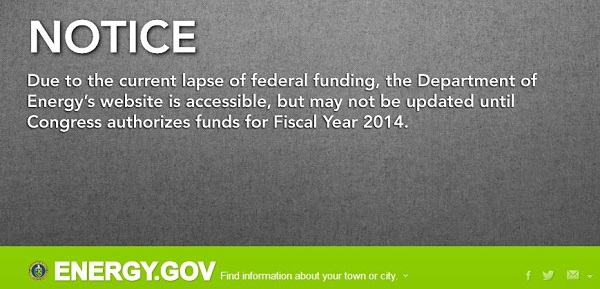Curious what the U.S. federal funding-bill impasse might mean for the energy sector, and clean energy in particular, I called a guy I know at the U.S. Energy Information Agency, a vital source of data, expecting to get a recorded message telling me he was unavailable.
But no, he was working, crunching numbers, as always. What’s up with that?

True, the EIA has just one “excepted employee” and two presidential appointees, the categories of workers who would continue working if funding ran out – but that’s the thing: The funding hasn’t run out. Yet.
The vast machinery of the federal government might have begun grinding to a halt on Tuesday morning, but it’s a slow grind. Reuters reported that the EIA, for instance, would operate “through approximately October 11.” As the U.S. Department of Energy, which oversees the EIA, put it in a document issued last Friday:
Unless otherwise noted, if a Departmental element does not have functions related to the safety of human life and the protection of property, all functions performed by that element will close if there is a lapse in appropriations and unexpended balances have been exhausted. All PAS employees will continue to report to duty.
So let’s sum up where we stand: Vital functions like keeping the grid operating and overseeing nuclear safety will go on no matter what. Beyond that, the shutdown’s impacts are scattered and uncertain as of right now, but in the short-run it should not have much effect on the overall direction of U.S. clean energy.
If the impasse isn’t broken within a few weeks, however, we could begin to see real problems developing. In addition to DOE, a key department on the clean energy front is Interior. Renewable energy projects that rely on the federal permitting through DOI and its agencies like the Bureau of Land Management, Bureau of Ocean Management and U.S. Fish and Wildlife Service – and that’s anything that touches on public lands, or undergoes environmental review for other reasons – could be delayed. This could include big solar and wind projects, as well as moves toward developing wind power offshore.
Likewise, while funded projects within the ARPA-E program won’t suddenly have their money pulled, program administration could become an issue. For instance, the DOE recently announced $66 million in funding for 33 projects aimed at developing more cost- and energy-effective ways to process and recycle metals [PDF]. But the DOE said these awards hadn’t been finalized, and ARPA-E has no excepted or presidentially appointed employees, so once it runs out of funding, the lights will go out on all activities.
As for the government’s many research labs, most are run by private contractors, which is likely to limit the impact for a while. But Sam Stein at Huffington Post has already reported on medical science projects being impacted by the shutdown; no doubt energy-related projects will soon feel the pinch as well.